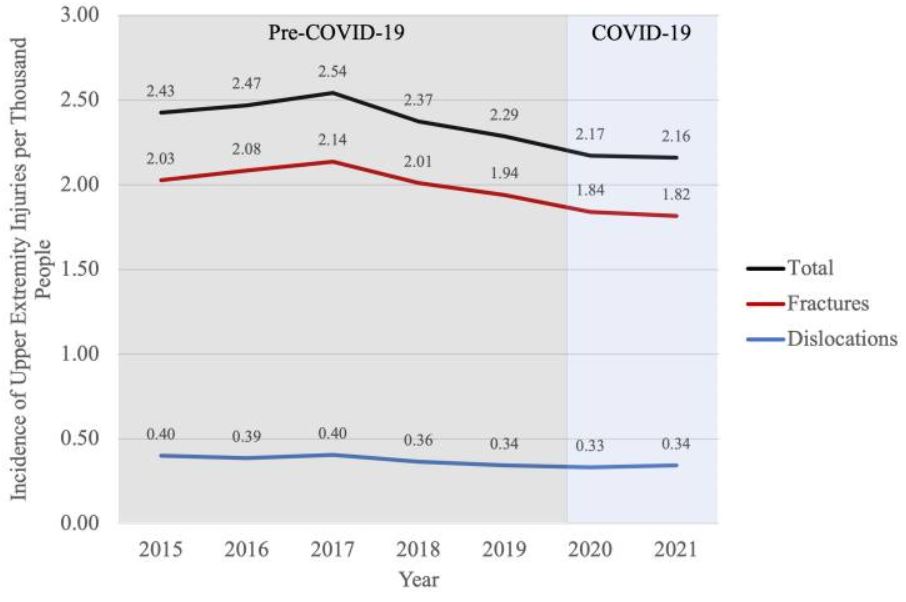
Click to Enlarge: Incidence of upper extremity injuries per thousand people by year. Source: National Library of Medicine
EL PASO, TX — Much of the focus during the COVID-19 pandemic has been on the infection itself, as well as persistent symptoms. But many other aspects of healthcare underwent changes of SARS-CoV-2 and the efforts to combat it.
“The widespread societal effects of the COVID-19 pandemic connote public health and epidemiological changes for orthopedic injuries,” wrote the authors of a recent study published in Cureus.
Yet, according to a study led by researchers from William Beaumont Army Medical Center and Texas Tech University Health Sciences Center in El Paso, there isn’t enough information on how the landscape changed. To remedy that, the study team conducted a cross-sectional, descriptive epidemiological study comparing epidemiological trends among upper extremity (UE) orthopedic injuries presenting to emergency departments (EDs) prior to and during the COVID-19 pandemic.
Data on Upper extremity fracture and dislocation came from the National Electronic Injury Surveillance System (NEISS) database in years prior to (2015-2019) and during the pandemic (2020-2021). Researchers collected information on incidence, patient demographics, injury patterns, mechanisms of injury, incident locale, and patient disposition were collected and compared between years.
They found that the pre-COVID-19 incidence rate (IR) of UE fractures at 2.03 per 1,000 persons (n=3038930 from 2015-2019) decreased to 1.84 per 1,000 in 2020 (n=474,805) and 1.82 per 1,000 in 2021 (n=471,793). At the same time, dislocation rates were largely unchanged at 0.34 per 1,000 people (n=476740) prior to the pandemic and with incidence rates of 0.33 per 1,000 (n=85582) and 0.34 per 1,000 (n=89386) in 2020 and 2021, respectively. Female patients over 65 had the highest injury IR at 4.85 per 1,000 (n=976,948), they said.
In a change, finger fractures (IR=0.38 per 1000, n=96009) overtook hand fractures (IR=0.51 per 1000, n=310710) as more common during COVID-19 in males, while wrist (IR=0.55 per 1000, n=350650) fractures remained most common in females.
“Injuries from individual sports, such as skateboarding and bicycling, increased during the pandemic, while injuries from team sports decreased,” the authors reported. “Hospital admission and observation increased in 2020, while discharge and transfer rates decreased. Admission, observation, and discharge rates moved closer to pre-pandemic levels in 2021.”
The researchers pointed out that the COVID-19 pandemic was associated with epidemiological and activity changes regarding UE fractures and dislocations presenting to EDs. They said their study demonstrates the following:
- Decreases in rates of upper extremity fractures and dislocations,
- Increases in rates of injuries related to outdoor and individual sports such as skateboarding with corresponding decreases in rates of injuries related to organized sports such as basketball,
- Increases in the rates of injuries occurring in homes and in association with pet supplies, and
- Decreases in rates of injuries occurring in schools and places of recreation observed during the pandemic.
“Additionally, trends observed among patient disposition specific to the pandemic, such as increasing rates of patient admission, observation, and against medical advice (AMA) departure with decreasing rates of discharge and transfer, offer insight into the burden of upper extremity injuries on the healthcare system during this critical time,” the researchers added. “While upper extremity orthopedic injuries remained common through the pandemic, the early pandemic was associated with higher rates of hospital admission that normalized closer to pre-pandemic levels by 2021, which may herald a shift and return to pre-pandemic trends. Future research will determine the long-term downstream effects of COVID-19 on activity-related orthopedic injuries and bone health.”
Background information in the study discussed the global decreases in patient volume across the trauma-care spectrum. The authors advised that significant reductions in ED trauma volumes were noted globally, with rates of patients presenting to U.S. EDs decreasing as much as 42% in general and 22% for musculoskeletal complaints.
“Specific to orthopedic trauma, a systematic review of fractures during the pandemic demonstrates significantly decreased fracture rates compared to pre-pandemic levels; however, there is evidence suggesting that the only upper extremity fractures with significantly altered proportions during the pandemic were hand and wrist fractures, while proportions of clavicle, humerus, and forearm fractures remained stable,” the study stated. “Other studies note no change in rates of distal radius fractures during the pandemic but propose concern for increased fragility fractures due to reduced physical activity in elderly populations, increasing the risk of developing or worsening osteoporosis in the future.”
Researchers in the current study suggested that their results are similar to those trends but appear “to be filtered through the lens of patient sex: among male patients, rates of hand fractures decreased significantly and were surpassed by the rate of finger fractures that remained stable from prior years. Wrist fractures in female patients continued to be the most common fracture pattern both before and during the pandemic. The high rates of wrist fractures and upper arm fractures observed in female patients over 65 raises concern for osteoporosis-related fragility fractures; however, the downstream effects of the pandemic on bone health and the treatment and management of osteoporosis remain to be seen.”
Home Injuries
They also posited that “the majority of non-sports-related products implicated in upper extremity fractures and dislocations are related to structural components of buildings and homes, such as floors, stairs, walls, beds, and doors,” adding, “With high rates of wrist and upper arm fractures in female patients over 65, a substantial portion of injuries from structural components such as floors and stairs may represent fragility fractures or fractures secondary to accidental falls.”
The study pointed out that the decreasing rates of upper extremity injuries from those components during the pandemic might reflect the greater propensity for injury in non-home buildings that are less familiar to patients than a home environment. The elderly especially tended to be confined to their homes, at least early in the pandemic.
“As previously discussed, the effects of decreased activity on bone health and the risk for fragility fractures remain to be seen,” the authors pointed out. “Interestingly, injuries related to pet supplies and equipment increased substantially during the pandemic. While there is debate surrounding whether rates of pet ownership increased during the COVID-19 pandemic, individuals who spent more time in their places of residence likely were more exposed to both their pets and existing pet equipment in their homes, increasing their risk for injuries from these specific products more so than other immobile, structural fixtures in their homes.”
The study posited that its findings on changes in injury trends during COVID-19 might “offer valuable insight into the evolution of athletic activities and sports during the pandemic. With many efforts to promote social distancing, including the suspension of organized sports, it is no surprise that sports-related mechanisms of injury exhibited sizeable decreases during the pandemic.”
As an example, it discussed bicycle use. “Reflecting existing consumer reports of biking popularity and corresponding bike production shortages, rates of bicycle-related injuries increased during the second year of the pandemic, with the incidence decreasing in 2020 before increasing in 2021 to higher than pre-COVID-19 rates,” according to the report.
The authors advise that rates of bicycle-related injuries are significantly divided by patient sex, with females having had a much greater decrease in bike-related injuries than males. “On the contrary, skateboarding injuries similarly increased during the pandemic; however, rates of injuries among female patients increased over eight-fold while rates in male patients did not even double,” they added. “Both biking and skateboarding reflect sports-related activities that can be performed individually and in an outdoor environment, which may explain their popularity in the setting of social isolation.”
Not surprisingly, the study found that injuries from team sports such as basketball and soccer decreased among both male and female populations during the pandemic, although decreases noted in female patient populations were much greater.
“Sports-related injuries in any extremity are estimated to result in fractures at a five-fold higher rate than dislocations; subsequently, while the considerable decrease in sports-related upper extremity dislocations more so than fractures is surprising, it may be explained by injury patterns specific to upper extremities given that nearly two-thirds of sports-related dislocations involved the shoulder or finger,” the researchers concluded. “The shifting proportions of injuries occurring in sporting/recreational facilities and schools to homes and farms or ranches further align with these findings and offer further insight into reported shifts in injury locale from outdoor or public locations to homes.”
- Sandler AB, Baird MD, Kurapaty SS, Scanaliato JP, Dunn JC, Parnes N. A New Normal: Trends of Upper Extremity Orthopaedic Injuries Nationwide During the COVID-19 Pandemic. Cureus. 2022 Oct 14;14(10):e30299. doi: 10.7759/cureus.30299. PMID: 36407135; PMCID: PMC9659313.


